 Years ago I picked up a science fiction dystopian novel called Red Rising on a whim. I needed a new book to read, and I’m a big fan of the genre. It ended up having a sort of a Hunger Games-on-Mars type of feel and I loved it. Written by Pierce Brown, this trilogy was much deeper than I expected as it took a look at a class-based society and what happens when someone doesn’t fit neatly into their role.
Years ago I picked up a science fiction dystopian novel called Red Rising on a whim. I needed a new book to read, and I’m a big fan of the genre. It ended up having a sort of a Hunger Games-on-Mars type of feel and I loved it. Written by Pierce Brown, this trilogy was much deeper than I expected as it took a look at a class-based society and what happens when someone doesn’t fit neatly into their role.
Fast forward to today, and we now have a Red Rising card game to sink our teeth into. Apparently, game designer Jamey Stegmaier has been trying to make this game for years, never actually being able to make it click. But finally, with the help of co-desiger Alexander Schmidt, he was able to bring something together. Were they successful? Let’s find out as we check out Red Rising, a hand-building, point salad board game for 1-6 players.
Gameplay Overview:
The goal in Red Rising is to score the most points over the game’s variable number of rounds. Each player starts with a hand of five cards out of a massive deck of 112. All cards in the game feature a character (some may be new/made up) from the Red Rising universe. On a player’s turn, they must either Lead or Scout.
To Lead (the main action), you take any character from your hand and place it to one of the four locations on the board. Most characters have a Deploy ability that triggers when used to Lead. These will usually let you manipulate the cards on the board in some way. After resolving that ability, you then can claim any face-up card in one of the other locations. Not only do you get to add that character to your hand, but you also get the ability of the location you pulled from.
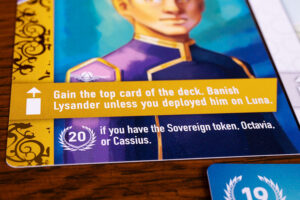
The locations are Jupiter, Mars, Luna, and The Institute. Most of these locations let you earn bonus points in some way, such as moving up on the fleet scoring track or placing an influence cube at The Institute. Luna is the outlier here which lets you claim the sovereign token. This is worth 10 points if you have it at game end and triggers your House power when you claim it. These are minor benefits that will do things like duplicate a location ability.
If you don’t want to Lead, you can Scout instead. For this, you simply draw a card from the character deck and place it in any of the four locations, earning that location’s bonus.
The end game triggers when someone has reached space 7 of the Fleet Track, someone has 7 cubes at the institute, and someone has collected 7 helium tokens. If one player achieves 2 of those or all 3 have been achieved by any combination of players, the game ends at the end of the round. Game end scoring will earn points from your characters in hand (they all have end game scoring powers), position on the fleet track, value of your helium, and amount of influence at the institute.
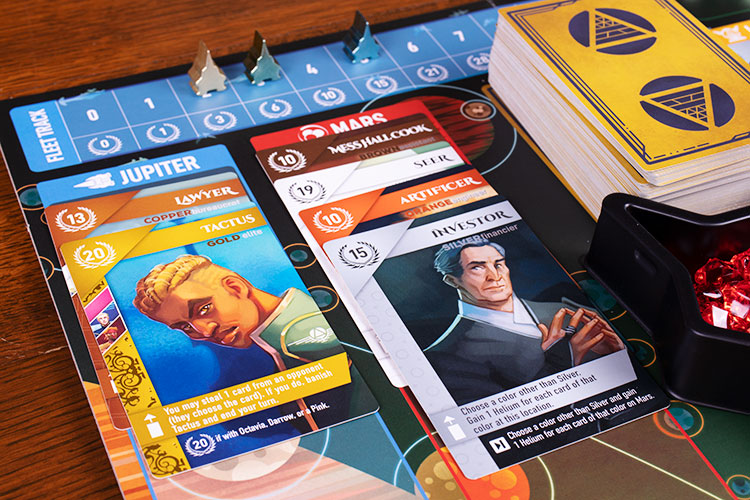
Game Experience:
When I heard from Stonemaier that there was a Red Rising game up for review, I eagerly snatched it up. I thoroughly enjoyed the book series and wanted to see what he could do with this world. Did the game live up to my expectations? Well… not completely. But before we jump into final thoughts, let’s dive into the details.
While the game is themed in the Red Rising universe I never really felt drawn in. I can say that the theme does go a bit farther than skin deep, it also could probably be swapped with some other theme and no one would have noticed. It’s been a while since I’ve read the books, but I do get the feeling that the designers tried to create the character’s powers around their book counterparts. So that’s good. But on the other hand, I kind of feel that the theme might have actually held this game back. And as I love thematic games, that’s something I never thought I’d say about a board game.
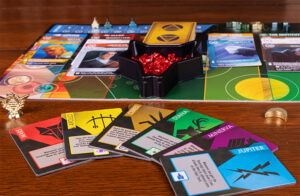
The reason is that there are 14 castes in the Red Rising world, which means there are 14 different colors of cards in the game—one for each caste. While this does provide a lot of diversity in the cards, it also makes it a crapshoot if you will ever draw the card you need. In one game, had a Pink card that desperately wanted to be played on a white card. Yet the entire game not one white card was drawn. In another game, I had a gold card that earned points by banishing blue cards…I’m sure you can guess where I’m going with this—only two blue cards ever showed up in that game.
I think Red Rising could have been a much better game with a whole lot more streamlining. There are just too many characters and colors which results in difficulty finding the synergy you need. Now, there are two colors that act as wilds for color or specific characters for end game scoring, but that doesn’t help you with powers during the game.
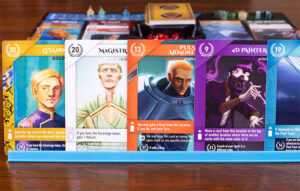
So let’s talk about the end-game scoring. When it works, it’s awesome. Scores will be in the 200+ range. You’ll earn points for a character’s base value, and then most have ways to get bonus points. Some examples include being (or not being) with a specific character or color. Yet because of the massive variety in cards, it all feels totally random if you get what you need. In my first game, 4 of the 5 starting cards I drew worked perfectly together and also with my House. So the game was easy. I just worked to find a replacement for that fifth card. Yet in another game, my starting had nothing working together (in fact, some were opposites), so I had to start from scratch with no direction of which way to go. This game relies a lot on the luck of the draw without a ton of ways to mitigate that.
In addition, after all my plays, I have no idea if this game is balanced. I’m not saying it’s not, nor that it is. There are 112 cards that all seem to be unique. I’m not a math guy, but either the designer had to have a solid formulaic spreadsheet to balance all this or brute force the heck out of it. In either case, I think I could play this 20 more times and still not be sure it’s balanced.
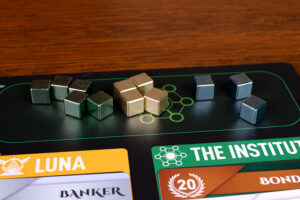
Yet not all is bad. Probably the most interesting thing about Red Rising is the decision-making on the cards. They are almost always powerful in some way. Either from their end game scoring powers or their Deploy abilities. Usually, those two go hand in hand, so that does create some tough decisions on how to use your limited selection of cards. Do you want powers now or points later? Those are the moments when the game really shines.
Yet once those decisions have been made, and players have a hand that works well for them, the end game begins to drag. Our group felt like we were just going through the motions, trying to ride things out. The game can’t end until there are enough points on the 3 end game areas. So we would just Scout, drop the card where we needed to place the token, and repeat till we had 7s across the board. At that point, the game was basically on rails.
Finally, as many of you probably expect, the production values in Red Rising are fantastic. The art is excellent, there are metal cubes for influence, shaped plastic helium tokens, and even shiny foil on the gold character cards. Everything just looks amazing. My only issue here was that the art, while looking great, takes up a bit too much real estate on the cards. There was a lot of hunching over the table trying to read the smallish font on the cards in the center of the table. So be prepared to get out your glasses.
Final Thoughts:
I keep bringing Red Rising back to the table because it’s a hard game to figure out. When things click, it can be really enjoyable. Yet when things aren’t going your way, it can be an exercise in frustration. The game depends a lot on the luck of the draw and the end game feels very mediocre compared to the early and mid-game.
While I won’t say that the theme is pasted on, I never really felt like I was spending time in the Red Rising universe. Some cards are indeed tailored to their color from the books, which was nice. But overall, you could swap out this theme with something else and no one would have noticed. So where does that leave us with Red Rising? I think it’s a good game, but probably would have been better with more streamlined play. It’s a game I’d play again if someone asked, but doubtful that I’d reach to pull it off the shelf very often.
Final Score: 3 Stars – A game that looks great and can definitely hook you in at times, but is too dependent on the luck of the draw from its thick deck.
 Hits:
Hits:
• Excellent production values
• Easy to learn ruleset
• Combos can be really fun to execute
Misses:
• Theme doesn’t go very far
• The luck of the draw plays too much of a factor
• End game can feel on rails























Wondering at what player counts you played the game and also how many times given the deck being so large can have an impact on how many cards you see in each play.
Well at the higher player counts you definitely draw more cards, just by the virtue of each player starting with a hand of 5. But what’s unique here is that there is no automatic draw at the end of a round or start of a turn. There aren’t a ton of cards that let you add cards to your hand. In fact, one game I lost a card due to a “take that” effect and never could find a way to draw a new cards.
Regardless, how many cards cycle through will depend a lot on what comes out. If people are happy with their hands early, they might start scouting sooner to see what appears and if it happens to be better. If there are some good cards on the board, those can get cycled through a few times as people pick up the card, use it for its effect and then someone else follows suit.
Unfortunately, we never were able to get the game played at the top end of the player count just due to limitations to the world we live in today. So its very possible that the deck gets cycled better at 6 players than at 3-4.
Cool. Thanks for answering my question so thoughtfully.
Finally glad to see a Stegmaier flop. It was inevitable at some point, and here we are.
Not sure i’d call this a flop, but I guess it depends on what your expectations are. I still think it’s a good game, just not a great one.
Why the hell would you look forward to seeing a game flop? Talk about salty.
That feels like a fair review of the game. Solid filler (ish) with nothing to get your teeth into. Priced fairly it could do quite well but it’s no Wingspan. From personal experience, luck of the draw issues can be a label for a number of games. I was even hurling abuse at the delightful critters in Everdell who would not show their cute little faces for me during a recent play.
Excellent review, Tony. Too often pre-release reviews are too positive and glowing about a game. I’m glad to have read a review that deals with potential game issues. It feels more honest than a typical pre-release review, so thank you for providing it. Paradoxically, your slightly negative review makes me more interested to learn about the game. I’m off to watch a gameplay review to help me make up my mind. Nice job!
Completely disagree with this being an average game. I absolutely love it. Cant stop playing it, and the automa is the best one I’ve played… leaving you to easily plan your combos. If you can’t find your colour then go look for grays. If you miss Darrow then go grab an orange.
I’m glad you are enjoying the game. If you are having fun, that’s all that matters. But I think you missed my point about colors. Grays and Orange only help you for end-game scoring. When you need colors during the game, you need to actually find cards of that color.